The rise and rise of the pumpkin in Germany
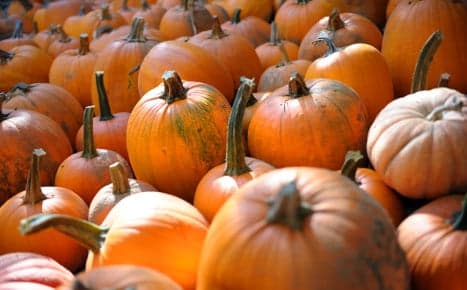
Germany has experienced a "pumpkin boom" in recent years. Where has this Teutonic love for an all-American vegetable come from, and where will it end?
This October in Germany, you won't be able to glance at food magazines on the shelves at REWE without coming across a pumpkin recipe. Kürbissuppe has become a staple in many households, and it appears on many restaurants' autumn and winter seasonal menus. The vegetable is so popular now, even German Starbucks has started selling their famed pumpkin spice in store.
What was once regarded as the food of the poor has now become popular among wide swathes of the German public due to the sheer variety available in markets and on supermarket shelves, Martin Krumbein of the Erfurt Horticultural Education and Research institute told the Frankfurter Allgemeine Zeitung (FAZ) in 2013.
The increasing popularity of the pumpkin in Germany is also reflected in the quantity of its harvest, as the Statista chart below shows. Since 2006, its harvest has more than doubled across the country. Over three quarters of Germany’s pumpkins are grown in Bavaria, North Rhine-Westphalia, Baden-Württemberg and Rhineland-Palatinate.
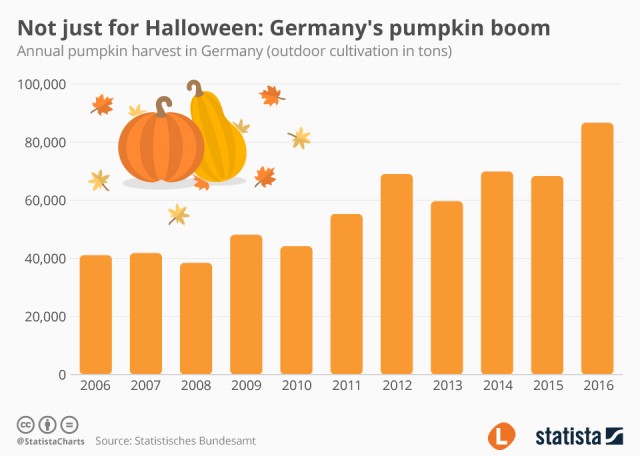 Source: Statista
Pumpkins are native to North America, and had been used by Native Americans for centuries prior to the arrival of European settlers, who both adopted them into their diet and brought them back to Europe. Since their first introduction to the continent, pumpkins have made quite a splash across the pond, specifically in Germany, and especially in recent years.
But today you won't find the largest pumpkin festival in the world in the USA or Canada. It's in Germany. The Ludwigsburg Pumpkin Festival (Kürbisausstellung), held every year in the small city of Ludwigsburg in Baden-Württemberg, currently holds that prestigious title.
Source: Statista
Pumpkins are native to North America, and had been used by Native Americans for centuries prior to the arrival of European settlers, who both adopted them into their diet and brought them back to Europe. Since their first introduction to the continent, pumpkins have made quite a splash across the pond, specifically in Germany, and especially in recent years.
But today you won't find the largest pumpkin festival in the world in the USA or Canada. It's in Germany. The Ludwigsburg Pumpkin Festival (Kürbisausstellung), held every year in the small city of Ludwigsburg in Baden-Württemberg, currently holds that prestigious title.
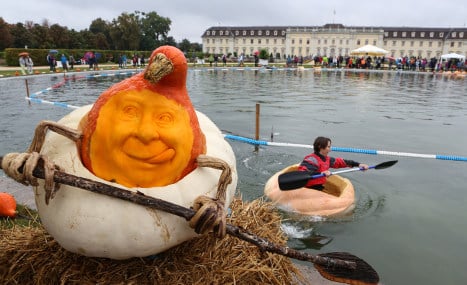 One of the events at this year's festival: The Pumpkin Canoe Regatta. Photo: DPA.
More than 450,000 pumpkins descend on this small city every year, outnumbering Ludwigsburg's inhabitants by more than 5 to 1. And 800 different species are represented among the around 150 tons of pumpkin that make it to the city.
What began in 2000, inspired by two brothers' (Beat and Martin Jucker) visit to a Swiss pumpkin exhibition, now attracts around 400,000 pumpkin lovers over a nine-week period. The festival is entering its 16th year and is a symbol of the growing popularity of the pumpkin in Germany today.
2014 was a special year for the festival, as it played host to the world's heaviest pumpkin during its European Pumpkin Weigh Off. This Swiss monster, weighing over 1 metric-ton, also meant the title went to a pumpkin grown outside the US for the first time.
Pumpkin fest organizer Stefan Hinner told The Local that the same pattern of increased pumpkin consumption that Krumbein saw on supermarket shelves could be observed among the visitors attending the festival.
At its inception, around 90 percent of the pumpkins brought to the festival were ornamental and 10 percent were sold to eat. However, in recent years that figure has almost completely reversed, with more and more festival goers taking home a pumpkin for their table.
Demand for pumpkins in Germany has grown significantly in recent years. From 2006 to 2013, the amount of pumpkins being produced in the Bundesrepublik increased by about two thirds. In 2013, a colossal 69,000 tons of the vegetable were harvested in the country, according to statistics gathered by FAZ.
This "pumpkin-boom" cannot only be attributed to Germans' newfound affinity for the delicious taste of pumpkin soup on increasingly cold autumn nights, but to another increasingly popular American import: Halloween.
The German Federal Statistics Office, as reported in FAZ, attributes the pumpkin's in vogue status in German to the rise in popularity and proliferation of the American custom of Halloween.
One of the events at this year's festival: The Pumpkin Canoe Regatta. Photo: DPA.
More than 450,000 pumpkins descend on this small city every year, outnumbering Ludwigsburg's inhabitants by more than 5 to 1. And 800 different species are represented among the around 150 tons of pumpkin that make it to the city.
What began in 2000, inspired by two brothers' (Beat and Martin Jucker) visit to a Swiss pumpkin exhibition, now attracts around 400,000 pumpkin lovers over a nine-week period. The festival is entering its 16th year and is a symbol of the growing popularity of the pumpkin in Germany today.
2014 was a special year for the festival, as it played host to the world's heaviest pumpkin during its European Pumpkin Weigh Off. This Swiss monster, weighing over 1 metric-ton, also meant the title went to a pumpkin grown outside the US for the first time.
Pumpkin fest organizer Stefan Hinner told The Local that the same pattern of increased pumpkin consumption that Krumbein saw on supermarket shelves could be observed among the visitors attending the festival.
At its inception, around 90 percent of the pumpkins brought to the festival were ornamental and 10 percent were sold to eat. However, in recent years that figure has almost completely reversed, with more and more festival goers taking home a pumpkin for their table.
Demand for pumpkins in Germany has grown significantly in recent years. From 2006 to 2013, the amount of pumpkins being produced in the Bundesrepublik increased by about two thirds. In 2013, a colossal 69,000 tons of the vegetable were harvested in the country, according to statistics gathered by FAZ.
This "pumpkin-boom" cannot only be attributed to Germans' newfound affinity for the delicious taste of pumpkin soup on increasingly cold autumn nights, but to another increasingly popular American import: Halloween.
The German Federal Statistics Office, as reported in FAZ, attributes the pumpkin's in vogue status in German to the rise in popularity and proliferation of the American custom of Halloween.
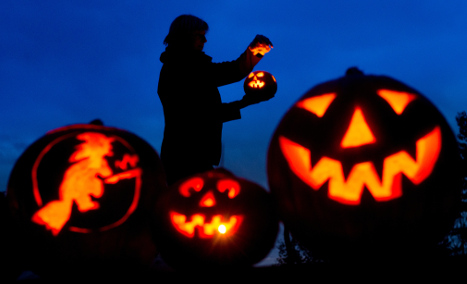 Photo: DPA The Jack O' Lantern is now an inseparable symbol of Halloween.
The carving of pumpkins may date back to the jack-o'-lantern, and the long tradition of carving lanterns into these vegetables in Britain and Ireland, however the carved pumpkin has now become part and parcel of American-style Halloween celebrations. The increased production of pumpkins can be linked to the growing popularity of Halloween, especially among younger people, across Germany.
Halloween is now big business in Germany, and thus big business for pumpkins. The Halloween industry is worth an estimated €160 million to the country's economy, according to a Spiegel interview with Dieter Tschorn, a public relations consultant widely credited with popularizing the festival in Germany in the mid-1990s. Tschorn attributes the sheer amount of pumpkins sold in Germany to this growing Halloween phenomenon.
A festive day placed only behind Christmas and Easter in terms of economic clout, means that more pumpkins than ever are being produced and carved in Germany.
Photo: DPA The Jack O' Lantern is now an inseparable symbol of Halloween.
The carving of pumpkins may date back to the jack-o'-lantern, and the long tradition of carving lanterns into these vegetables in Britain and Ireland, however the carved pumpkin has now become part and parcel of American-style Halloween celebrations. The increased production of pumpkins can be linked to the growing popularity of Halloween, especially among younger people, across Germany.
Halloween is now big business in Germany, and thus big business for pumpkins. The Halloween industry is worth an estimated €160 million to the country's economy, according to a Spiegel interview with Dieter Tschorn, a public relations consultant widely credited with popularizing the festival in Germany in the mid-1990s. Tschorn attributes the sheer amount of pumpkins sold in Germany to this growing Halloween phenomenon.
A festive day placed only behind Christmas and Easter in terms of economic clout, means that more pumpkins than ever are being produced and carved in Germany.
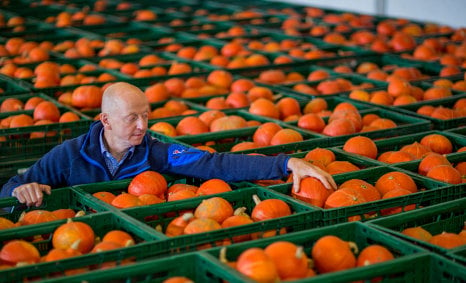 A farmer from Mecklenburg-West Pomerania prepares for Halloween. Photo: DPA.
So, from North America to Europe, from a food reserved for the poor to a gourmet delicacy, right up to the largest pumpkin festival in the world, the rise of the pumpkin in Germany has been a stratospheric one. The question is, will the orange bubble continue to grow or will it burst?
By Charley-Kai John
*This article was updated on October 27th, 2017.
A farmer from Mecklenburg-West Pomerania prepares for Halloween. Photo: DPA.
So, from North America to Europe, from a food reserved for the poor to a gourmet delicacy, right up to the largest pumpkin festival in the world, the rise of the pumpkin in Germany has been a stratospheric one. The question is, will the orange bubble continue to grow or will it burst?
By Charley-Kai John
*This article was updated on October 27th, 2017.
Comments
See Also
This October in Germany, you won't be able to glance at food magazines on the shelves at REWE without coming across a pumpkin recipe. Kürbissuppe has become a staple in many households, and it appears on many restaurants' autumn and winter seasonal menus. The vegetable is so popular now, even German Starbucks has started selling their famed pumpkin spice in store.
What was once regarded as the food of the poor has now become popular among wide swathes of the German public due to the sheer variety available in markets and on supermarket shelves, Martin Krumbein of the Erfurt Horticultural Education and Research institute told the Frankfurter Allgemeine Zeitung (FAZ) in 2013.
The increasing popularity of the pumpkin in Germany is also reflected in the quantity of its harvest, as the Statista chart below shows. Since 2006, its harvest has more than doubled across the country. Over three quarters of Germany’s pumpkins are grown in Bavaria, North Rhine-Westphalia, Baden-Württemberg and Rhineland-Palatinate.
 Source: Statista
Source: Statista
Pumpkins are native to North America, and had been used by Native Americans for centuries prior to the arrival of European settlers, who both adopted them into their diet and brought them back to Europe. Since their first introduction to the continent, pumpkins have made quite a splash across the pond, specifically in Germany, and especially in recent years.
But today you won't find the largest pumpkin festival in the world in the USA or Canada. It's in Germany. The Ludwigsburg Pumpkin Festival (Kürbisausstellung), held every year in the small city of Ludwigsburg in Baden-Württemberg, currently holds that prestigious title.

One of the events at this year's festival: The Pumpkin Canoe Regatta. Photo: DPA.
More than 450,000 pumpkins descend on this small city every year, outnumbering Ludwigsburg's inhabitants by more than 5 to 1. And 800 different species are represented among the around 150 tons of pumpkin that make it to the city.
What began in 2000, inspired by two brothers' (Beat and Martin Jucker) visit to a Swiss pumpkin exhibition, now attracts around 400,000 pumpkin lovers over a nine-week period. The festival is entering its 16th year and is a symbol of the growing popularity of the pumpkin in Germany today.
2014 was a special year for the festival, as it played host to the world's heaviest pumpkin during its European Pumpkin Weigh Off. This Swiss monster, weighing over 1 metric-ton, also meant the title went to a pumpkin grown outside the US for the first time.
Pumpkin fest organizer Stefan Hinner told The Local that the same pattern of increased pumpkin consumption that Krumbein saw on supermarket shelves could be observed among the visitors attending the festival.
At its inception, around 90 percent of the pumpkins brought to the festival were ornamental and 10 percent were sold to eat. However, in recent years that figure has almost completely reversed, with more and more festival goers taking home a pumpkin for their table.
Demand for pumpkins in Germany has grown significantly in recent years. From 2006 to 2013, the amount of pumpkins being produced in the Bundesrepublik increased by about two thirds. In 2013, a colossal 69,000 tons of the vegetable were harvested in the country, according to statistics gathered by FAZ.
This "pumpkin-boom" cannot only be attributed to Germans' newfound affinity for the delicious taste of pumpkin soup on increasingly cold autumn nights, but to another increasingly popular American import: Halloween.
The German Federal Statistics Office, as reported in FAZ, attributes the pumpkin's in vogue status in German to the rise in popularity and proliferation of the American custom of Halloween.

Photo: DPA The Jack O' Lantern is now an inseparable symbol of Halloween.
The carving of pumpkins may date back to the jack-o'-lantern, and the long tradition of carving lanterns into these vegetables in Britain and Ireland, however the carved pumpkin has now become part and parcel of American-style Halloween celebrations. The increased production of pumpkins can be linked to the growing popularity of Halloween, especially among younger people, across Germany.
Halloween is now big business in Germany, and thus big business for pumpkins. The Halloween industry is worth an estimated €160 million to the country's economy, according to a Spiegel interview with Dieter Tschorn, a public relations consultant widely credited with popularizing the festival in Germany in the mid-1990s. Tschorn attributes the sheer amount of pumpkins sold in Germany to this growing Halloween phenomenon.
A festive day placed only behind Christmas and Easter in terms of economic clout, means that more pumpkins than ever are being produced and carved in Germany.

A farmer from Mecklenburg-West Pomerania prepares for Halloween. Photo: DPA.
So, from North America to Europe, from a food reserved for the poor to a gourmet delicacy, right up to the largest pumpkin festival in the world, the rise of the pumpkin in Germany has been a stratospheric one. The question is, will the orange bubble continue to grow or will it burst?
By Charley-Kai John
*This article was updated on October 27th, 2017.
Join the conversation in our comments section below. Share your own views and experience and if you have a question or suggestion for our journalists then email us at [email protected].
Please keep comments civil, constructive and on topic – and make sure to read our terms of use before getting involved.
Please log in here to leave a comment.